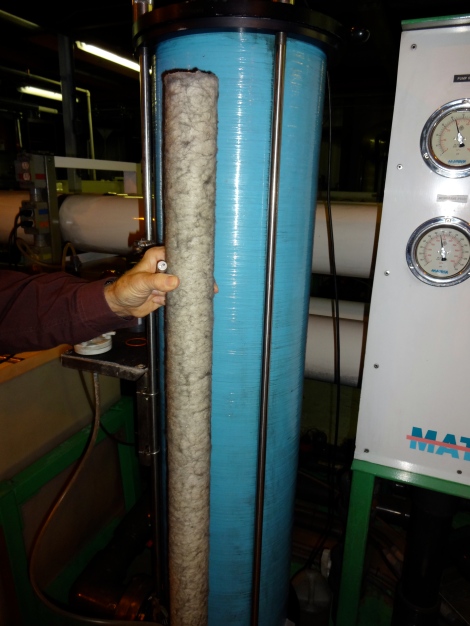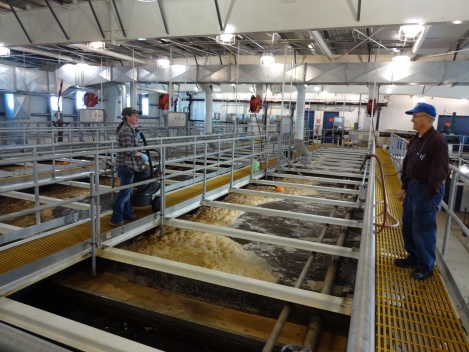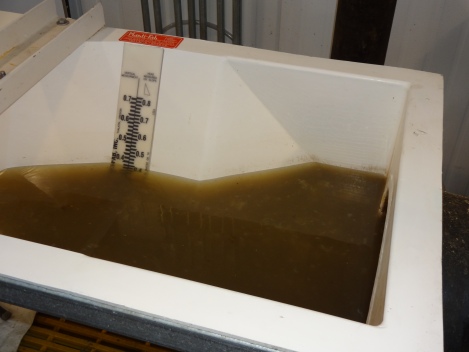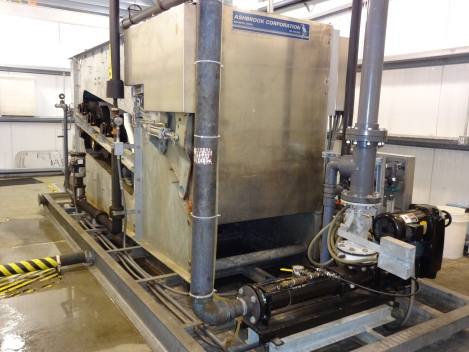Power Up: What Keeps McMurdo Going?
A few days ago I visited several places that I’ve always wanted to see here in McMurdo. I’ve never had the time to visit the power plant, water plant, and water treatment plant. WOW! I’m blown away by the technology and science used in these three facilities. It reminds me of how STEM (science, technology, engineering, and math) is everywhere in our lives.
I started by talking with Sarah Durand at the power plant. Sarah is a power plant technician from Haines, Alaska. This is her eighth season in Antarctica. Two of those seasons were spent at South Pole Station. The current power plant was remodeled and added on to in the 2009-2010 season, so it’s quite modern. Total production would be 7,800 kilowatts with the six generators, and 990 kilowatts with the wind turbines. Now, that’s if everything on the station was running at once…which doesn’t really happen.
This station has four large CAT (Caterpillar) diesel generators, and two smaller CAT generators. The wind turbines are a joint venture with Antarctica New Zealand, and helps supply power to Scott Base. The wind turbines were erected in 2010.
This is the switch gear and something called the “bus” feeds power to different places on station and also over to Scott Base. Scott Base converts the power to their voltage, which is different than what we use in the U.S.
Our station hits peak load during the day and uses two megawatts of electricity. A kilowatt is 1,000 watts (think of a 60 watt light bulb…and go bigger!) and a megawatt is 1,000 kilowatts. That’s BIG power! At night, the station’s energy use drops to 1,200 kilowatts. Fewer people are up and working during those nighttime hours.
On a good day, (meaning lots of wind) the wind turbines can produce one third to one half of the power needed to run McMurdo Station. In that case they could run the wind turbines and one smaller generator. But, if the wind isn’t blowing or power is interrupted for some reason, the generators will kick in and provide the power we need. There is what’s called a “redundancy system” next door. The two small generators are housed in this building. In case of emergency, these can be used.
This is a computerized power plant system and Sarah’s job includes monitoring the computers to make sure things are running smoothly.
If you look closely, you can see tiny wind turbines on the computer screen. The three wind turbines are on the hill between McMurdo and Scott Base. If you’d like to see a photo of them, go to my blog for December 3rd because I had a great view of the wind turbines when I climbed Observation Hill.
A very interesting fact is that the power plant uses the waste heat that’s generated. It’s recycled through to other buildings. This is extremely efficient. 700-900 gallons per minute of waste heat glycol is pumped through pipes connected to buildings.
I walked right through the same building into the water plant. This is where our drinking, bathing, cooking, etc. water is produced. Think about it, where do you think we get our water? It is pumped into the water plant from McMurdo Sound. I met with Paul Jones, who I’ve known for years through the TEA (Teachers Experiencing Antarctica and the Arctic) Program. Paul’s first visit to Antarctica was as a teacher in this program, back in fall of 1997. This is his 8th or 9th season working in McMurdo…he couldn’t remember. He’s worked in all three plants that I’m talking about today, although he says the water plant (where he is now) is his favorite.
The first thing Paul showed me…the tanks of carbon dioxide, which are like giant fire extinguishers. They are stored in this area in case of fire in the power plant next door.
Sea water is pumped into this plant and purified for our use. Years ago the sea water was boiled and the steam was re-condensed in a process called distillation. This process uses a lot of diesel fuel. The salt was taken out of the water of course, and this process is called desalinization. About ten years ago this new water plant was built and a more modern method of purification was adopted. Now the process used is reverse osmosis. Paul gave me a good example of how to explain this to you. (once a teacher, always a teacher!)
In reverse osmosis, it’s like putting a wire screen on your kitchen window. The screen lets the air through, but not the flies. If you want to stop mosquitoes, you would need a screen with smaller holes. They filter the salt water by pushing it through a filer system using air moved by a powerful fan. Membranes (filters) with tiny holes allow the water to pass through but capture the salt. It takes a huge amount of pressure to make this happen. They build up this pressure to 600 pounds per square inch. Think of your car tires, they are inflated to 25-30 pounds per square inch and truck tires are inflated to 75-80 pounds. That comparison might help you understand just how much 600 pounds per square inch is; it sure helped me.
The first line of defense; a rapid sand filter that catches the “big stuff.” Paul is standing by these filters in the photo below.
The next line of defense is a five micron filter. A micron is a microscopic unit of measurement. A series of filters inside of this large cylinder are designed to catch the tiny particles. There are 10-12 filters inside the cylinder. The long gray thing is one of several filters inside of the rapid sand filter. This is one that has been used and you can see how dirty it is.
The last line of defense — water is filtered through layers of tiny screens compacted into the cylinder shown below.
Here is what those screens look like close up…see how many layers there are?
And, each one of those cylinders is housed inside of one of the horizontal white pipes. Paul is demonstrating this in the picture below.
78 gallons of water come into each unit per minute; 28 gallons leave the unit per minute. Clean water is stored in four gigantic tanks, each holding 50,000 gallons of water. Fresh water storage here in McMurdo is 200,000 gallons of water. By rule, the water plant must be sure to keep two of the tanks full at all times. They rotate which tanks are being emptied and filled and as one tank goes down in level, another goes up. This is indicated on a gauge located on the outside of the tanks.
This is one of the 50,000 gallon storage tanks.
The waste glycol is also recycled in this plant, and sent to other areas of McMurdo, such as the dorms, as the photograph below demonstrates.
Paul and his colleagues at the facility test the water to be sure it has a proper PH (acidity) balance. Nuetral PH is 7, and they try to keep the PH of our water a bit above that at 8.9. To balance the PH they use sodium carbonate, which is like baking soda. They also add a small amount of chlorine to the water to kill germs. It’s much smaller amount than you would even put into a swimming pool.
Paul told me that in case of emergency or a power failure,there is an emergency shut off procedure. Starting and stopping this water purification process is not easy though, which is why workers keep at least one line running all the time. After my tour of the water plant, Paul walked me over to the nearby water treatment plant. Yes, folks, this is where our body waste and gray water (such as from showers and sinks, and the kitchen) goes!
I met Becky Bragg, who has a degree in environmental science and biology. Becky has worked in Antarctica for fourteen seasons, in McMurdo, at South Pole Station, and at Palmer Station on the Antarctic Peninsula (south of South America). She says that her job at the waste water treatment plant is to maintain a healthy environment for the microbes (microscopic life in the water). The water they “treat” or clean up gets pumped into McMurdo Sound. Years ago, the waste water and solid waste was put directly into McMurdo Sound. Times have changed and there is a strict environmental protocol about waste generated on this continent.
The foam you see on the top of the waste water is bacteria that feeds on the greases and fats in the water. This plant cycles through/processes about 45,000 gallons of water a day at the moment. The peak amount was 52,000 gallons per day, but they haven’t seen that level this season. During the winter when the population of McMurdo Station drops sharply, they process about 8,000-12,000 gallons of water per day.
Okay, let’s go through this process. First the waste and water is sent to this treatment plant.
Yes, it looks disgusting. Solids are screened out in this contraption shown below.
Next, the water is sent to one of three “trains” (compartments/tanks). I’ve photographed one of the trains, shown below.
Here’s what the trains look like in operation.
The sludge is pumped off the bottom of these tanks as it settles, and that’s put through a belt press. The belt press squeezes the water out of the sludge.
The material that comes out of the belt press is called “cakes.” It is sent down a chute to a room below. It reminded me of a heap of compost.
The cake material fills large plastic lined boxes and packaged for shipment (and disposal) back to the United States. This shipment is part of what goes back on the resupply vessel that brings supplies to McMurdo Station.
Meanwhile, back upstairs in the three trains, this is an example of what the water looks like after it’s been cleaned. The darker spots in the water are marks on the pipe, not impurities in the water.
One of Becky’s jobs is to monitor the levels of bacteria and microorganisms in the waste water.
Becky showed me some of the microorganisms by using her high powered microscope and projecting what she was seeing onto a larger computer screen. Cool science! (and kind of gross at the same time) We were seeing amoeba, ciliate, vorticella, rotifer, and more!
Here is a short video clip of tardigrada, or also called water bear. I thought it looked like a miniature sea otter. There was so much life moving around under this microscope…holy cow!
There is about a half mile between the intake of sea water from McMurdo Sound for our water plant (what becomes our fresh water) and the outflow from the water treatment plant…going into McMurdo Sound. The outflow is down current from the intake. I have a new appreciation for the power, water, and waste water treatment at McMurdo Station. There is so much science that goes into making this station run smoothly. Thanks to Sarah, Paul, and Becky for the great job teaching me more about these important places in McMurdo.































This begs the question: how do we dispose of the “cake” material back here in the states? I also wonder how much waste from other places around the world is shipped back here. That’s your NEXT research project, Betty.
I have the same question as Ann above……
Hi Ann, April, and Steve, this is Chris.
My educated guess is that it is composted.
It is all organic matter for the most part so that would be the logical destination. If there are inorganic wastes they would be directed toward recycle or as a last resort landfill. That is why McMurdo teaches all residents “Garbology 101” upon arrival so the know how to sort, segregate and dispose of their refuse. This helps assure the waste water is all organic.
That’s so cool I love you blogs mrs.tumle
Thanks
That is a lot of equipment. But I guess you need it down there.
Hi Mrs.Trummel!
I love your blogs!that is a lot of equipment to run the station! Well I guess it’s a big place so u must need all that!
See u soon! Leah
50,000 gallons WOW! That’s a lot.
I love your blog especially my little brother loves it too
Who’s hi?
Btw I love you mrs t
Awesome! That is a crazy amount of electricity being generated!
Thank you for the great blog!
Pingback: Quora·
You guys are performing Miracles it is very interesting how they work together if I were a bit younger I volunteer to work at nearly any of the stations having skills I might be capable of working there keep up the good work and God bless you all
Pingback: Polar Opposites | Suomi NPP (National Polar-orbiting Partnership)·
I believe this is among the such a lot important info for me. And i’m satisfied reading your article. But want to statement on some normal issues, The site taste is perfect, the articles is really great : D. Excellent task, cheers
Love watching sunset !
Pingback: Powering the lunar base, version 2 - My Blog·
CT would love contact with someone who knows early history of the first reactor they used at McMurdo